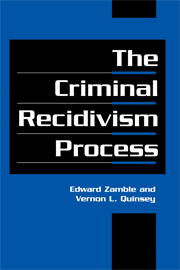Book contents
- Frontmatter
- Contents
- List of Illustrations and Tables
- Preface
- 1 Introduction: The Prediction of Criminal Behavior
- 2 The Study
- 3 Recidivists: A General Profile
- 4 Comparisons with Nonrecidivists
- 5 Comparisons across Offender Groups
- 6 Comparisons within Offender Groups
- 7 Final Considerations
- References
- Appendix: Interview Form
- Index
4 - Comparisons with Nonrecidivists
Published online by Cambridge University Press: 02 February 2010
- Frontmatter
- Contents
- List of Illustrations and Tables
- Preface
- 1 Introduction: The Prediction of Criminal Behavior
- 2 The Study
- 3 Recidivists: A General Profile
- 4 Comparisons with Nonrecidivists
- 5 Comparisons across Offender Groups
- 6 Comparisons within Offender Groups
- 7 Final Considerations
- References
- Appendix: Interview Form
- Index
Summary
although the information on behavior of reoffenders in the community allows us to construct a picture of recidivists' lifestyles, moods, and outlooks that has some use in understanding criminal behavior generally, the data presented so far do not allow us to address questions of proximal causation very effectively. On the basis of the data, we cannot say which events actually influence the commission of new offences, and which are epiphenomenal. For example, high rates of unemployment or of depression may be determinative of recidivism, or they may be characteristic of marginal populations, or of people who have recently undergone major transitions in their lives. Moreover, some of the specifics of the results may have been produced by features of the method of inquiry. In short, conclusions are impossible without information on comparative or marginal rates.
Our group of men who had been released and who had not reoffended provides comparative data. Any area in which this group does not differ from the set of recidivists is unlikely to be a precursor of renewed offending. The use of this comparison group does not control for all possible confounding variables, but it does match recent past experience of imprisonment and release, and it will allow us to narrow the broad picture shown in the preceding chapter. Although the comparison group is relatively small in comparison to the recidivist group, it is large enough to allow statistical comparisons, certainly where differences are sizeable or consistent.
- Type
- Chapter
- Information
- The Criminal Recidivism Process , pp. 69 - 94Publisher: Cambridge University PressPrint publication year: 1997

